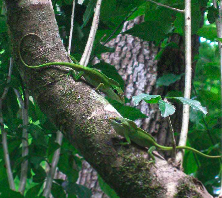

| Visitors Now: | |
| Total Visits: | |
| Total Stories: |
Winners Are Right-Brained – Visual Lateralization In Aggressive Encounters

Aggressive encounter between anoles. The top male is watching his opponent with his left eye, while the lower male is using his right eye. Photo: Johnson Lab, Trinity University
Have you ever gotten an angry look from an anole? Has he ever displayed at you, demanding that you get out of his territory? If so, chances are that if an anole was giving you the stink eye, he with using his left side! I’m blogging live from the Society for Integrative and Comparative Biology (SICB) meeting in San Francisco. My first stop has been to view Michael Patton’s poster examining the neuroanatomy of aggressive behavior. Patton is a senior undergraduate student at Trinity University working with Dr. Michele Johnson. Early birds at SICB have the opportunity to put their posters up for early viewing, so I got a sneak peek of his work last night although he’s not slated to present until Saturday.
For his project, Michael addressed the question of brain lateralization in aggressive displays. Some evidence suggests that anoles tend to favor their left side during competitive encounters. Patton and colleagues built on these studies by examining behavioral laterality in the field and neuroanatomy in the lab in the same individuals. Through observations of wild A. carolinensis, Patton found support for this idea – the winning male tended to view his opponent from his left side!
We know that visual signals in Anolis cross the optic chiasm in the brain, and project to the contralateral visual cortex. Additionally, there appears to be little integration between hemispheres for neural input. This means that the right side of the brain should know what the left eye has seen, but not what the right eye sees. In light of this, Patton’s follow-up question was – is there lateralization in brain structures, as well? To this end, he examined soma size and density in the preoptic area (POA), which is the first stop for visual signals in the brain, and the amygdala, one of the brain centers associated with aggression. He found a greater soma size for neurons on the right side of the POA, but no differences in size in the amygdala. Cell density did not differ between right and left sides in either brain region. This result makes sense – if lizards are favoring their left eye for contests, then the right POA should be receiving more signals, and soma size should be larger. However, this increase in visual input is not translating into greater cell size in the amygdala or cell density in a major brain center for aggressive behavior. Any thoughts on why this might be occurring? Right or left-brained ideas are both welcome, of course.
2013-01-04 08:34:19
Source:



